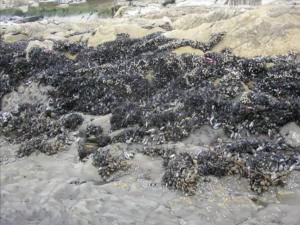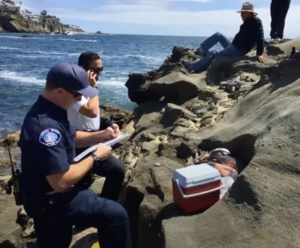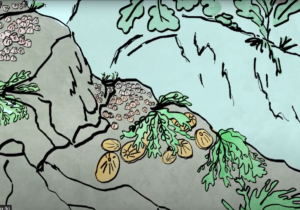Rocky Intertidal Community Roundtables Recap
n August and September 2020, USC Sea Grant and Cabrillo Marine Aquarium presented a series of three virtual community dialogue roundtables (via Zoom) on the ecological importance and human use of rocky intertidal habitats along the coast of Southern California. This series was created in response to the recent changes in human activity in tidepool habitats along the Palos Verdes Penninsula this spring and summer, and aimed to address these ecosystems, how they are being altered, the impacts of harvesting these fragile species, and their capacity to recover. Additionally, it’s important to remember that people visiting tidepools are not homogeneous, either by demographic or purpose, and the series sought to raise awareness and address the issue that many members of the community have only a partial understanding of all the elements, ecosystem values, cultural connection through food, legal harvesting, regulations, and the challenges and barriers in place limiting coastal access. The series also respectfully acknowledges that we live and work on the land of the Tongva, Gabrielino, and Chumash peoples, and extend gratitude and respect for the elders of past, present, and emerging. This series aims to honor the models indigenous people have provided for living in a respectful relationship with the ocean and coast, as well as to learn from our indigenous partners and neighbors on how to respect responsibility for one another including the environment, each other, and ourselves.
Roundtable Series Recap
The three-part community roundtable series included presentations from a variety of stakeholders including researchers, organization and agency representatives, and community members, as we work toward a common understanding of the science, policy, and education of rocky intertidal ecosystems. The events were focused on (1) Longterm Monitoring: Understanding the Changing Intertidal, (2) Management, Policy, and Enforcement in the Rocky Intertidal, and (3) The Intersection of People and the Rocky Intertidal. Each of the three roundtable events hosted by USC Sea Grant and Cabrillo Marine Aquarium included a panel of guest speakers relevant to the event’s topic and emphasized dialogue between participants and guest speakers by providing a platform for community members to ask questions and share ideas. Summarized descriptions of each of the three events are provided below.
 Panel I: Understanding the Changing Intertidal (Watch here)
Panel I: Understanding the Changing Intertidal (Watch here)
The first roundtable event occurred on August 12, 2020, and focused on the longterm research of the rocky intertidal ecosystem. It featured presentations from four expert researchers and facilitated discussion on the ecology of Southern California’s rocky shore ecosystems, changes it is experiencing, and human’s influence on these changes. Mr. Steve Lee, with the Somona Ecology Center and MARINe (Multiagency Intertidal Monitoring Network), began the conversation by discussing the importance of the rocky intertidal communities, especially focusing on mussels and how they are an ecosystem engineer that creates a habitat for over 100 species.
He further shared his work on monitoring their changes over time in areas such as White Point Beach and shared his observations of over 20 years. Next, Dr. Susanne Lawrenz Miller, with Cabrillo Marine Aquarium, shared about her research with the aquarium studying population changes of the intertidal along the Palos Verdes Peninsula. Especially, she focused on the lifestyle of black abalone and the huge changes observed in their habitat that unfortunately resulted in the extreme decline of their species. The next speaker, Dr. Alan Miller with California State University, Long Beach, discussed examples of species recovery. He focused on the region’s sea stars and how their population is influenced by changes such as diseases from warm sea surface temperatures and the trends of their recovery. The final presenter, Dr. Steve Murray with California State University, Fullerton, focused on the active influence of human impacts on the rocky intertidal, both by engagement of harvesting as well as just by moving through the tidepools and the impact of trampling while observing. The session ended with a discussion period with participants.
 Panel II: Management, Policy, and Enforcement in the Rocky Intertidal (Watch here)
Panel II: Management, Policy, and Enforcement in the Rocky Intertidal (Watch here)
The second roundtable event occurred on August 26, 2020 and focused on the management, policy, and enforcement in our rocky intertidal areas. The primary responsibility for California’s coastal resources lies with California’s Department of Fish and Wildlife (CDFW). This session included six panelists, four representing California’s Department of Fish and Wildlife, and two representing the municipal jurisdictions of the City of Laguna Beach and the City of Rancho Palos Verdes. The session began with three presentations on the policy, management, and enforcement for these important habitats in Southern California. Sonke Mastrup presented on behalf of the four California Department of Fish and Wildlife staff specializing in policy, enforcement, and outreach. Additional panelists available from CDFW included Mike Stefanak, John Ugoretz, and Becky Ota. This presentation covered the issue of fisheries management of tidepools, the development and continual evolving enforcement of department tidepool harvesting regulations, the impacts of environmental and human impacts on tidepools, and the types of department response including outreach and increasing enforcement. Shifting towards local enforcement efforts, Porter Hogan, representing the City of Laguna Beach as their Marine Protection Officer, presented on his position and other city efforts to protect marine protected areas and tidepools including a large focus on community education through its junior lifeguard program, local school visits, and tidepool educators.
The final presentation continued on the local efforts of the city of Rancho Palos Verdes. Led by Norma Saldana, she shared about two new programs focused on enforcement in their areas: the Open Space Management program which primarily focuses on educating patrons about proper use, and a park ranger program focused on enforcement. The remaining portion of the event included rich discussion across all six participants on varying topics about current challenges and human influences facing these fragile ecosystems. Such topics discussed included good tips of implementing enforcement, the importance of public stewardship, outreach materials, and the impact of COVID-19.
Note: To report illegal activity in tidepools, contact the CalTIP hotline system at 888 334-2258 (open 24/7)
 Panel III: The Intersection of People and the Rocky Intertidal (Watch here)
Panel III: The Intersection of People and the Rocky Intertidal (Watch here)
The third and final roundtable event occurred on September 9, 2020, and focused on the intersection of people and the rocky intertidal. This event included three presenters that focused on education strategies about the rocky intertidal through outreach and communication. This session expressed how important communication is as a tool to catalyze how we can work together to bridge the challenges faced by Blacks, Indigenous communities, and other peoples of color in connecting with and accessing the coastline while still working to maintain healthy coastal ecosystems. The first presenter, Stefie Gan, is a graduate student with the USC School of Animation and was an artist in residence this summer with the Wrigley Institute for Environmental Studies. She spoke about using animation as a communication tool. She shared her career path and passion for communicating ideas of sustainability and climate change and how to create intricate animations that portray powerful messages. She shared an animation video she recently created about the importance of tidepools, which can be viewed here.
The second presenter, Candice Dickens-Russel, works at the DoGoodery Social Impact Agency and shared about her extensive work at the intersection of equity and the environment. She focused on the complex topic of how we can create education for everyone, as well as described a multitude of key steps of effective community education, with examples from the multiple experiences throughout her work. The final presenter, Holly Suther, works at California State University, Fullerton for the Multi-Agency Rocky Intertidal Network (MARINe). She talked about her experience of how to use social media as a tool for science communication. Topics discussed include common misconceptions of the intertidal, effective steps for how to increase the awareness and understanding of social media to promote good stewardship, and using analytics to determine how to write successful media posts. The remaining portion of the webinar focused on the discussion of how to address complex issues and provide education about protecting our natural resources to all communities in a welcoming way.
Resources
These roundtable discussions continue to lead to further action by supporting outreach and education about the tidepools, increasing understanding of human use of the tidepools through monitoring, and most importantly working together with Black and Indigenous, Chinese American, and other communities to develop better communication and pathways for all in the tidepools.
- A link to the flyer to provide guidance on regulations for intertidal harvesting can be found here.
- For a list of outreach and education resources on our rocky intertidal, click here.